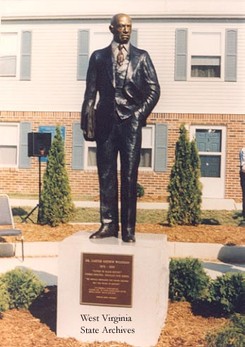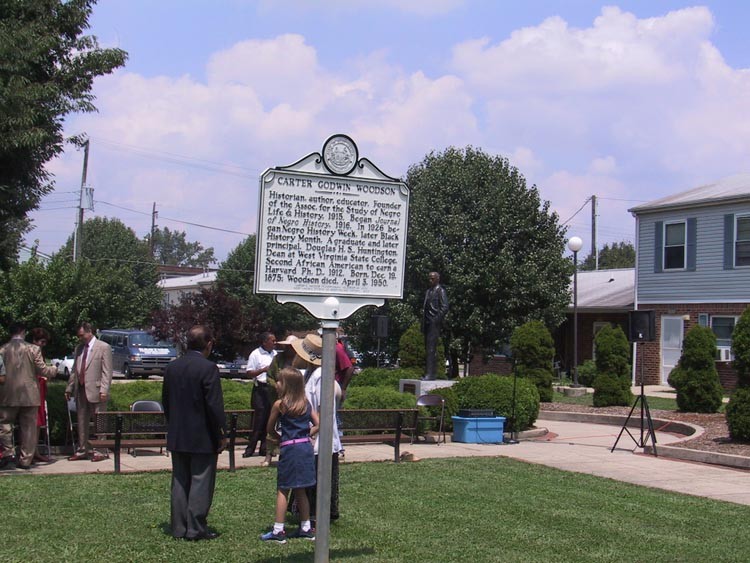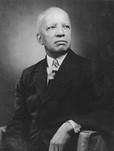Carter G. Woodson Statue
Introduction
Text-to-speech Audio
Carter G. Woodson, known to many as "the Father of Black History,” was born to former slaves and worked in the mines of West Virginia before graduating from Berea College, the University of Chicago, and Harvard University, where he earned his Ph.D. Woodson believed that educating the populace about Black history had the power to transform society, improve race relations, and benefit people of all races. Woodson was educated in the segregated public schools of Huntington, West Virginia, and became the principal of his former high school after completing a teacher certification program at Kentucky's racially integrated Berea College. He went on to earn a M.A. from the University of Chicago and a Ph.D. from Harvard University. Woodson founded Negro History Week in February of 1926, and his efforts to grow this annual celebration of Black history and culture led to the creation of Black History Month. Woodson also created the Journal of Negro History and the scholarly and community organization known today as the Association for the Study of African American Life and History. These institutions, together with his scholarly and popular books, journals, and articles, provided a platform for educating others about African American history with works written by Black and white scholars. Woodson was among one of the first scholars to research and publish works on slavery from the perspective of the enslaved.This statue was commemorated in 2003, and is said that Woodson's line of sight is directly pointed at the first location of Douglass High School.
Images
Carter G. Woodson Statue as it stands today.

Benos, Deanne. "Woodson Project Ground Broken." The Herald Dispatch [Huntington] 30 May 1992: Print. Marshall University Special Collections
![Benos, Deanne. "Woodson Project Ground Broken." The Herald Dispatch [Huntington] 30 May 1992: Print. Marshall University Special Collections](https://storage.googleapis.com/clio-images/medium_14585.26396.jpg)
Preparing for dedication of roadside marker in 2003. www.wvculture.org.

Carter G. Woodson

Backstory and Context
Text-to-speech Audio
Carter G. Woodson was born in Buckingham County, Virginia, on December 19, 1875, where he grew up working on a farm. Carter’s family temporarily moved to Fayette County, West Virginia, in the 1880s so that his father could work in the railroad industry, and he and his brother could work in the coal mines. In 1895, when Carter was 20 years old, he enrolled in high school at Frederick Douglass High School and completed all the coursework required to graduate in just two years. After graduating in 1897, Carter attended Lincoln University in Pennsylvania, but graduated from Berea College in Kentucky in 1903. Berea had been a higher education institution established by abolitionists in the 1850s with the purpose of educating ex-slaves, and Carter graduated one year before Kentucky made a law prohibiting interracial education. Carter returned to Frederick Douglass High School after graduating college to teach, and also spent four years teaching in the Philippines.
Carter G. Woodson valued education more than anything in life, and believed that it was the key to transforming society, improving race relations, and benefiting the lower classes. He enrolled in the University of Chicago in 1907 to better educate himself, and graduated with a bachelor’s and master’s degree in European History; his thesis was on French diplomatic policy toward Germany in the eighteenth century. In 1909, Woodson was accepted to Harvard University and earned his Ph.D in history in 1912 with the assistance of scholarships. Woodson’s dissertation was never published, but it was on the events leading to the creation of the state of West Virginia after the Civil War broke out. After Harvard, Woodson taught in Washington until 1919 at the Armstrong and Dunbar/M Street high schools. From 1919 to 1920, Woodson was the dean of arts and sciences, professor of history, and head of the graduate program in history at Howard University. Then from 1920 to 1922, Woodson taught at the West Virginia Collegiate Institute, followed by a return to Washington to direct the Association for the Study of Negro Life and History full time.
While Woodson was earning ranks in higher education, he was also still working on his passion project of spreading knowledge of African American history to all levels. The Journal of Negro History began publication in 1916, to provide a platform for works in Black history. Woodson believed that if African American history was taught at all levels it would diminish racial issues, and founded the annual celebration of Negro History Week in February 1926. The Journal of Negro History led to the creation of the Negro History Bulletin, another platform that could be used to publish African American history works, and the Negro History Week turned into what we now know at Black History Month. The Journal of Negro History was a pure form of equality; not only did the journal provide a place for Black scholars to be published, but it also provided a place for white scholars to be published when their ideas of slavery or Black history did not fit the well-known white narrative. The journal provided multiple topics on Black history such as slavery, the slave trade, Black culture, the family, religion, and antislavery and abolitionism, and included biographical articles on prominent African Americans.
Negro History Week increased awareness of and interest in Black history among both Blacks and whites, and was chosen to be celebrated at that time because of Frederick Douglass and Abraham Lincoln’s birthdays. Each year, he sent promotional brochures and pamphlets to state boards of education, elementary and secondary schools, colleges, women's clubs, Black newspapers and periodicals, and white scholarly journals suggesting ways to celebrate. Woodson provided these institutions with primary and secondary sources to be handed out as information, and eventually Negro History Week was being celebrated in every state in America, and even reached some foreign countries.
Woodson changed the way America viewed the Black population by using new sources and methods, such as census data, slave testimony, and oral history. This information made Americans realize that Blacks were not just victims of white oppression, but they were vital and major roles in America’s development. The NAACP awarded Woodson with the highest honor, the Spingarn Medal, in June 1926, because of his endless efforts to promote African American history. Woodson directed the Association for the Study of Negro Life and History until his death in 1950; today there are multiple scholarships and programs dedicated to his life and research.
Sources
Jacqueline Goggin. "Woodson, Carter Godwin";
http://www.anb.org/articles/14/14-00718.html;
American National Biography Online Feb. 2000.
Access Date: Wed Nov 02 2016
Bickley, Ancella R. "Carter G. Woodson." e-WV: The West Virginia Encyclopedia. 03 December 2015. Web. 02 November 2016.
